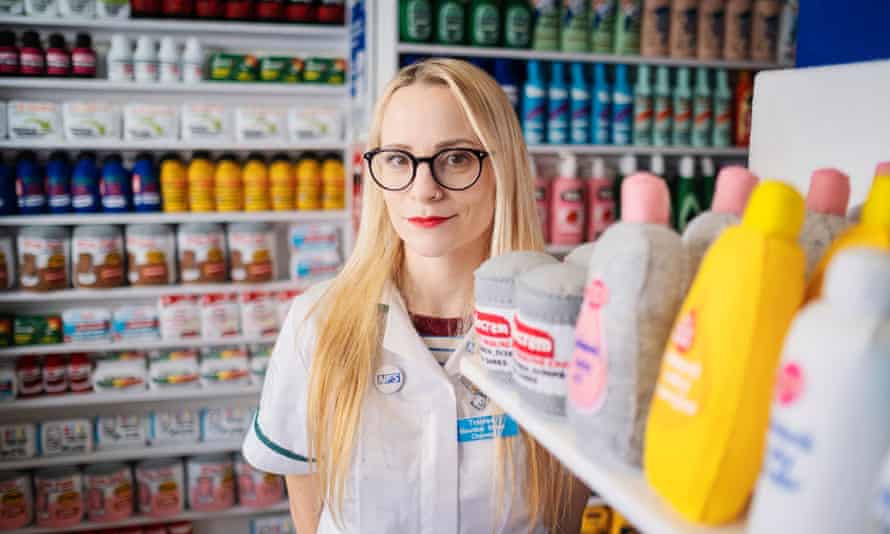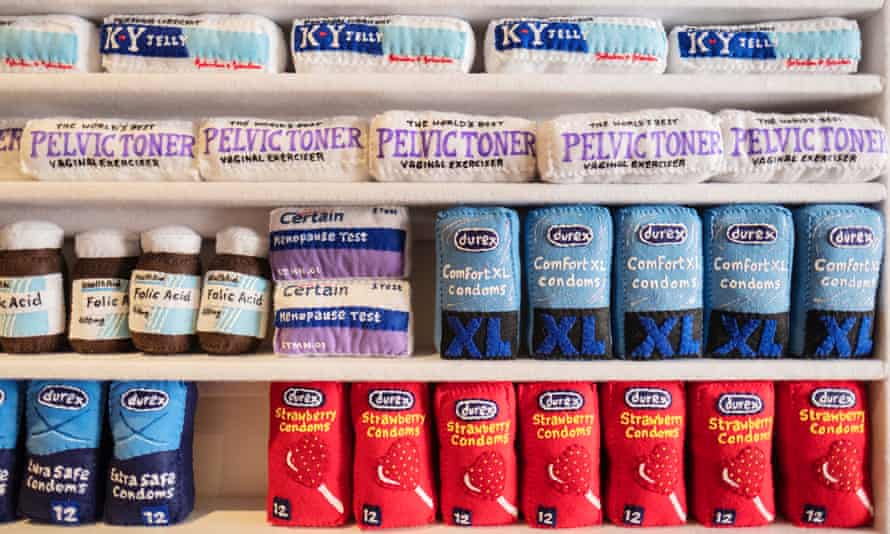Lucy Sparrow thinks she spoke 15 words a day in the depths of lockdown. As she dispenses artworks to an eager public from the mad felt chemist’s shop she has created, she says she is making up for it big time.
“It is all the words I should have said in the last year concentrated down to three weeks,” she said. “I’m chatting to absolutely everyone who comes in.”
Sparrow, in her NFS (National Felt Service) white coat, is behind the counter of the felt pharmacy she has installed in a gallery in Mayfair, London. All the bookable slots have been filled but every day a small queue forms of hopeful walk-ins, people desperate to see and experience art in the flesh.

With England’s museums and galleries not able to reopen until 17 May, art-lovers are heading to commercial galleries which were allowed to open on 12 April. Over the weekend, a “West End gallery hop” attracted large numbers clutching a map of 40 galleries to visit and finally see art.
Sparrow is resident at the Lyndsey Ingram gallery, where visitors enter what appears to be a normal chemist’s shop. It has a strong smell of TCP and Deep Heat. Thousands of products have been painstakingly recreated in felt, each one hand sewn and painted.
There are cough sweets, strawberry-flavoured condoms, haemorrhoid creams and toothbrushes. Behind the counter are prescription drugs like Tramadol and Prozac. All the works of art can be picked up and bought, from £30 to the several thousands.

Bourdon Street Chemist has taken Sparrow more than a year to create and stems from a childhood making felt versions of things she could not always have. Aged seven she would make her own toys, sweets and fried breakfasts. “I’ve still got them … my mum and dad were encouraging me to do it. It was a mad, fantasy world.”
Everyone who comes to the shop is very chatty and many are socially awkward after lockdown. “As if the British weren’t socially awkward enough. We can’t shake hands so we have to do this awkward thing of just standing there.”
Visitors over the weekend included marketing manager Beatrice Ramirez and her five-month-old son Hector, whom she plans to take to lots of art shows. “I really like art and I think children learn to behave when they’re in galleries.” She has missed the live art experience. “It has been boring during lockdown.”
Another visitor, Linda Brough, an art lover and purchaser of some felt Lemsip Blackcurrant, said: “It has been awful not having anything to see and I get really fed up with Zoom. I like to see art for real. With the best will in the world it just isn’t as good on a screen.”
That joyous feeling of finally seeing art up close is being replicated in galleries across Mayfair.

Joe La Placa is director of Cardi Gallery in Grafton Street, showing works made from inner tubes, tyres and spent car oil by the Italian Arte Povera artist Paolo Canevari.
La Placa said he felt like a deep sea diver coming up slowly for air. “It does feel like Mayfair is coming alive, it is a regeneration.
“I was coming to the gallery during lockdown and you could fall asleep in the street and not be run over, it was unbelievable. It was a ghost town. But now it’s coming alive and I guess people have saved some money so they are starting to spend and they are just so happy to be out … to see the world again, to talk, to see art.
“No matter how good you get with the virtual stuff it’s still not the real thing.”
All commercial galleries have adapted during the pandemic making better use of video, social media and online viewing. Jean-David Malat, founder of the gallery JD Malat, said that requests for works through the gallery’s online channels were 40% higher in 2020 than 2019.

He is showing swirly abstract paintings by the Icelandic artist Katrin Fridriks. “They are very blue and positive and what we need right now.”
Gallerist John Martin said galleries had learned so much in the past year, doing things they had spent a long time putting off. “The engagement we’ve had with people during lockdown has been incredible, people got so in to it … they were really digging deep in to artists in a way that I’ve never known before.
“We’ve been seeing new people coming to the gallery who are incredibly well-informed, they are really hooked.”
This content first appear on the guardian
